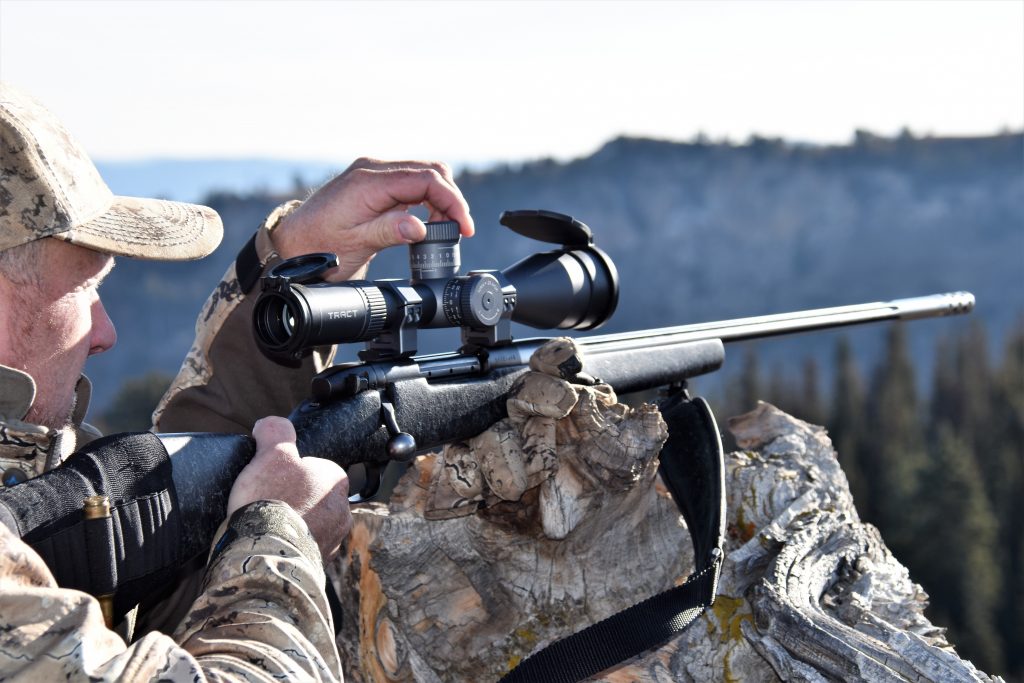Understanding rifle scope turrets can drastically improve your long-range capabilities.
Think about your rifle scope turrets as a translator. By themselves, the turrets do not change where the bullet impacts. However, on properly set up rifles they help the shooter process information to know where the bullet will impact. For the most part that information is contained by adjusting the reticle up, down, and side to side until the scope and the bullet’s path become one. Keep reading below to find out how to best utilize the translation and begin understanding rifle scope turrets.
Understanding Rifle Scope Turrets
The windage and elevation dials are the two most important turrets. Once your scope is properly mounted on your rifle, you must adjust your windage and elevation knobs to set your rifle’s zero. When looking through the scope, the windage knob is located on the right-hand side of the scope and adjusts the reticle left and right. Similarly, the elevation knob is located on top of the scope and adjusts your reticle up and down. Both turrets must be adjusted in harmony to zero a rifle. Once the rifle is zeroed, each turret can be adjusted to account for each individual shot.
Using the Impact Ballistics program, you can match your cartridge and reticle, and even the atmospheric conditions where you'll be shooting. With the ability to print out a dope chart based on the information you enter, you can carry your ballistic data with you to help increase impacts at a long range.
JL demonstrates the simple and accurate way of sighting in your rifle scope.
Elevation
When a bullet is shot, its speed causes the round to resist Earth’s gravitational pull, causing it to fly towards a target rather than falling straight to Earth. As wind resistance slows the bullet’s flight, it begins to drop more substantially as Mother Earth tightens her grip.
This is most commonly experienced when shooting over long distances. As a result, the shooter must do one of two things. The easiest and fastest solution is to hold the reticle above the target to compensate for the dropping round. Even with a lot of experience, it’s nothing more than an educated guess.
The more precise solution would be to use a rangefinder. This will allow you to measure the distance to your shooting position and dial your turret to match that range. In this case, the shooter would move the reticle lower inside the scope so he or she would then have to raise the barrel higher to put the reticle on target. Likewise, the shooter should know the calculations of his or her scope to know how many revolutions the dial should be turned to match certain distances.

Windage
Windage works in a similar way but left and right instead of up and down. While gravity pulls a round downward and is countered by aiming higher, wind can cause a round to move left or right in varying amounts.
For precision shooters, windage can interfere with a round impact as much or more than gravity. The first thing the shooter needs to determine is the wind direction. On longer-range shots, the wind can gust in many different directions across varying parts of the shot path. Looking at visual cues, like flags, trees, grass, etc., or using wind indicators can be very helpful to determine wind direction. A wind speed indicator is also necessary for those who desire ultra-precise adjustments.
Once shooters know wind direction and wind speed, they can either utilize “Kentucky Windage” and guess their hold to counteract the wind or refer to a ballistics chart to know exactly how many clicks to move their reticle based on the wind direction and wind speed for their specific round. In either case, the conditions should be reassessed as wind speed changes.

Making precise elevation adjustments in the field is quick and easy once you know the distance.
Parallax Rifle Scope Turrets
The third turret is the parallax adjustment dial. It is mounted on the opposite side of the scope from the windage dial. Parallax occurs when the reticle and the target are not on the same focal plane. It causes the reticle or the target to appear blurry. While it may seem like the parallax adjustment is somewhat of a focusing knob, accuracy can be greatly affected if the reticle and the target aren’t focusing on the same plane. In other words, a clear sight picture is just the byproduct of lining up your reticle and your target in the same focal plane.
Before adjusting the parallax, make sure your reticle is focused. Mount your rifle and look at a plain background like a white wall or the sky. Don’t look continuously through the reticle. Only look through the reticle in 1-2 second bursts. Your eye muscles will try to adjust to the sight picture and provide a biased result otherwise. If the reticle is not perfectly clear, pull the scope down and slightly adjust the focus dial on the scope’s eyepiece. Then offer another quick glance and repeat until the reticle is tack sharp.
With the reticle in focus, peer down the sight at your target. Adjust the parallax adjustment dial until the target is also in focus. Dismount the rifle and check the reticle once more against a plain background to make sure it’s still in focus. If both reticle and target are in focus, they are focusing on the same focal plane.
Learning the math and the ballistics of a round can be a lot of fun and a lot of work. For a shortcut, consider a set of our Custom Turrets. We will gather data relevant to your specific rifle and load and will construct a set of turrets specific to your rifle. Then all you need to do as the shooter is dial, point, and shoot.


